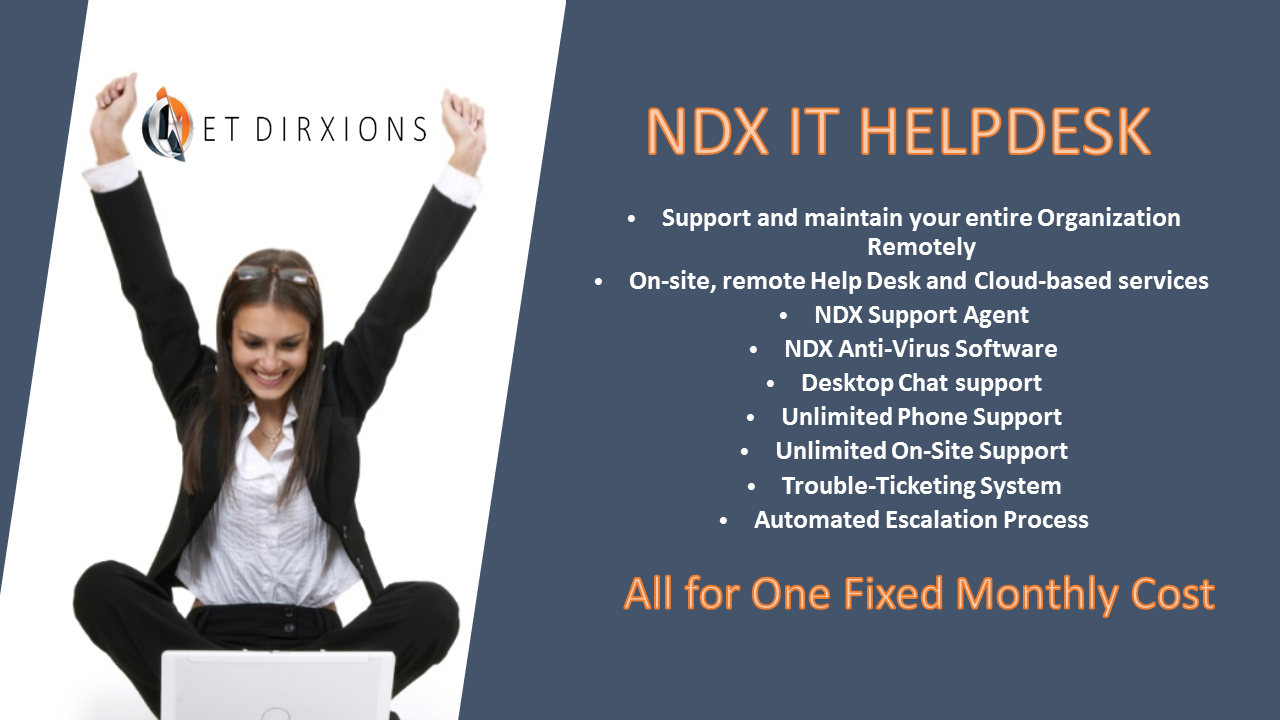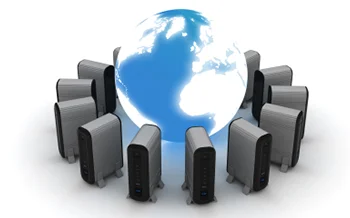Fully Managed Backup & Disaster Recovery
Fully Managed Backup & Disaster Recovery
If the power in your office fails tonight, and all of your computers crash, how quickly can you recover? And more importantly, at what cost? According to the U.S. Department of Labor, 93% of companies that experience a disaster go out of business within 5 years – even if they can recover in the short term.
We’re here to ensure your business doesn’t become another statistic. Our business continuity solution is about more than just backup – it’s designed to quickly revive your network following any unplanned downtime, and ensure your employees are operating productively in almost no time at all.
• Complete end-to-end management of backups
• Block-level encryption
• Continuous Data Protection technology
• Fully-managed & monitored
• Cloud replication
• Off-site virtualization
Unparalleled Peace of Mind
In today’s always-on business landscape, maintaining an effective backup and disaster recovery (BDR) strategy is becoming more important than ever before. Data is playing an increasingly critical role in decision-making processes, and the costs and risks associated with downtime are skyrocketing – not to mention the damage your brand and reputation can suffer in the event of a disaster.
Net DirXions’s business continuity solution includes features like continuous data protection, cloud-based replication and recovery, and more – all for one low fixed monthly price per protected server.
What does that mean? It means you can rest easy knowing that your critical data, emails, reports, and other information are all protected, backed up and securely tucked away until you need them.
Direct Support
Having a backup appliance in place is only the first step in a successful business continuity strategy. To minimize the risk of data loss as much as possible, you’ll want to have technicians proactively monitoring the entire backup process to ensure things are working as expected.
That’s why we’ve got a dedicated team keeping a watchful eye over your protected servers, ready to jump into action should any problems arise. And if the worst should happen, don’t worry – we’ll have you back up and running quickly.
Net DirXions Help Desk and Managed IT Services
Full Problem Resolution & Expert Customer Service
In the world of IT, problems happen. Computers crash, passwords are lost, email stops working, and the list goes on. And without proper technical support in place, these problems can bring your business to an abrupt – and potentially damaging – halt.
With Net DirXions’s Help Desk, you can enjoy peace of mind knowing that our certified technicians can quickly and efficiently resolve even your most complex technical problems.
Proactive Care & Maintenance
Not every support issue can be called a catastrophe…until it prevents you from being able to do your job. We’re here to help you stay ahead of the curve, so you can focus on growing your business – and to do so, we’ve adopted a proactive approach to network monitoring and IT maintenance.
That’s why our help desk is a seamless extension of our remote monitoring platform. So when you call to report an issue, there’s a good chance we’re already aware of the problem you’re experiencing – and are actively working to resolve it.
Our technicians receive regular training, coaching and quality review to continuously sharpen their skills, and they’re backed by a team of professional supervisors and managers to ensure consistency and unmatched service delivery. Our technology certifications include:
• Microsoft and Apple desktop operating systems
• Microsoft Office and leading third-party applications
• E-mail applications and Web browsers
• Thin clients and virtual desktop infrastructure (VDI)
• Hardware and network troubleshooting
• Printer installation and support
• Mobile phones and tablets
• User administration
• Desktop performance problems
• Virus and malware infections
Three Steps To Fix IT Management for SMBs
Three Steps To Fix IT Management for SMBs
Small-to-medium-sized businesses (SMBs) tend to have a more difficult time managing IT than larger enterprises. Despite being as technology dependent as larger enterprises, SMBs have tighter budgets and fewer resources to devote to IT management. This leads to a more reactive “break-fix” approach to their technology that never does any smaller company or organization any good.
Here’s what break fix most often leads to. If the burden rests on the shoulders of hourly or salaried in-house IT support, and they’re too busy putting out fires all day, then their skills and talents are essentially wasted.
If there is no in-house tech support, and many smaller companies and organizations don’t have even one onsite “IT guy”, SMBs are commonly taken for a ride by some of the more unscrupulous on-call IT consultants.
Although “If it ain’t broke, don’t fix it” is a popular saying, it should never be applied to the management of business technology. The cost of downtime can crush any barely surviving small business. The combined impact of lost revenue, lost productivity, and lost brand reputation is a severe hit that many SMBs aren’t built to withstand.
It pays to be proactive, not a reactive about technology. This requires a cultural shift from how IT has commonly been handled in the past. Say goodbye to manual, yet necessary, processes and hello to a better way for businesses to meet their technology needs – a smarter and more cost-efficient way.
Three Steps To Better Manage Your Business Technology
Be Proactive – More often than not, it’s the things that aren’t caught early on that turn into costly business disruptions. For instance, many of the hardware, software, and application failures that cause downtime occurrences are preventable; they’re just not detected and addressed early enough.
SMBs today have the advantage of using a Remote Monitoring and Management (RMM) tool to help their existing in-house support staff get a grip on their workload.
A RMM tool, combined with an outsourced 24/7 Network Operations Center (NOC), monitors your technology all day and all through the night via one comprehensive interface that is even accessible with a mobile device. This kind of around the clock monitoring transforms technology management. Problems can be nipped in the bud with an alert and prompt ticket resolution before they turn into major issues that disrupt day-to-day operations.
Automate/Schedule Mundane Tasks – Free the in-house support staff from everyday manual maintenance and monitoring by automating a broad range of IT security and monitoring tasks.
Get More From Your In-House Team – If you have any in-house IT support, you’ve likely hired some incredibly skilled and talented people who would be more worthy contributors to your company or organization if they weren’t always so tied up fixing things and performing monotonous tasks. With RMM and NOC solutions, SMBs can put these individuals to work on projects that matter. They are freed-up to work on concepts, strategies, and application development that better serve your customers, employees, and suppliers, truly giving business a competitive advantage.
Inquiring SMBs Want to Know… What’s the Difference Between a Help Desk and NOC?
Inquiring SMBs Want to Know… What’s the Difference Between a Help Desk and NOC?
It’s no secret that any growing small-to-medium sized business must monitor and manage its business technology in the most cost-efficient way. The tricky part is figuring out how to do this without sacrificing the overall experience of the end-user. End-users can be clients and customers or employees. Both rely on the efficiency of a firm’s network, servers, and applications, and the availability of the company’s data center.
Thanks to the evolution of managed services, it’s actually possible these days to reduce costs, which strengthens IT support and infrastructure. It’s just a matter optimally integrating all available resources.
It’s a Staffing Conundrum for Most SMBs
Most SMBs tend to be short staffed. This isn’t just another reference to the many SMBs with little to no onsite tech support. While that’s true, and problematic, it’s actually all operations that tend to be short staffed.
Small yet growing companies and organizations aren’t just short on tech support; it seems like even their administrative assistant needs an assistant to keep up. Customer support and sales teams are also overworked, and often hindered by having to understand and troubleshoot tech problems when they have no tech expertise whatsoever.
There is no, “Hold for a moment, Sir. I’m about to transfer you to our tech support team.” There is no tech support team.
This is where managed service providers (MSPs) step in to save the day. MSPs help SMBs better manage their technology to achieve greater ROI (Return-on-Investment). One way they do this is by augmenting a SMBs existing on-site staff with the remote support of a 24/7 Network Operations Center (NOC) and Help Desk.
What’s the Difference Between a NOC and Help Desk?
This question is asked a lot because it’s really not uncommon to see both referenced interchangeably, which leaves many to assume they are one in the same. They are not. Here is the easiest way to distinguish between the two.
NOC: Most of the work performed by a NOC focuses on the network and systems. The NOC can almost be viewed as a mission control center. They monitor and manage an IT network. A 24/7 NOC typically monitors the network and system security, performance, and backup processes.
Help Desk: The Help Desk is more customer-oriented. The Help Desk has interaction with the end-user, or someone representing the end-user, to directly respond and resolve technical problems as they arise. Customers or employees can typically reach the Help Desk by clicking a support icon,
The Benefits of a Managed Service Provider
Managed Service Providers – or MSPs – are often recommended as a cost effective IT solution for small businesses. For a minimal monthly fee, MSPs provide a reasonably priced solution to the complex technology pains of small businesses. Here’s a look at the various benefits an MSP can offer your business…
- Freed-Up Resources and a Renewed Emphasis on Core Business – Both business owners and internal IT staff would much rather focus on revenue enhancing tasks like product development or the creation of cutting-edge applications/services. This is one reason routine monitoring and maintenance tasks are often neglected by an internal IT person or team, which always proves to be detrimental much later.
Often misportrayed as a “threat” to an internal IT person or staff, MSPs can instead relieve internal staff of mundane network operations maintenance, repetitious monitoring of server and storage infrastructure, and day-to-day operations and help desk duties.
- A True Partner Sharing Risks And Responsibilities –The goal of an MSP is to deliver on contracted services, measure, report, analyze and optimize IT service operations, and truly become an irreplaceable catalyst for business growth. Managed Service Providers not only assume leadership roles, they enable risk reduction, enhance efficiency and change the culture by introducing internal IT operations to new technologies and processes.
- Access to Expertise, Best Practices and World-Class Tools and Technologies – MSPs have experience with a variety of businesses and organizations. Managed Service Providers can keep your business relevant and on track with continually evolving technology, support, and productivity demands. Let’s face it, no small or medium sized business can afford to fall behind with technology trends in today’s business world.
- The Benefit of a Full-Time Fully Staffed IT Department at a Fraction of the Cost – Most small business owners live and die by proactive management. They just haven’t had the budget, resources or access to on-demand expertise to be proactive with information technology management. A Managed Service Provider gives business owners and overwhelmed internal IT staff affordable computer and server support, remote monitoring of critical network components like servers and firewalls, data backup and disaster recovery, network security, custom software solutions, and technology evaluation and planning.
Managed Service Providers can decrease the overall IT support costs by as much as 30% to 50%. Rather than being stressed about technology, business owners can instead get back to focusing on growing their business. All while enjoying the benefits of highly-trained IT experts boosting their network’s reliability and performance.
It is Heaven! Using the Cloud to Challenge Big Business
It is Heaven! Using the Cloud to Challenge Big Business
Has anyone suggested you begin moving your business to the cloud? Cloud data storage or cloud computing? What is this, anyhow? And isn’t it something for huge companies?
In the last post we explained what cloud computing is. Simply put, it is the offsite storage of your data, and perhaps even the software packages you use. The primary benefit is pretty straightforward. Somebody else pays for all the hardware and support costs needed to store your data. You pack up all your own servers, wiring, etc. and take them to the recycling center, and save money. But is that all it is? There is a much stronger case for a small business to incorporate the cloud in their business model. The cloud allows you to become competitive with the big players in your industry.
The traditional issue holding back small business: they do not have the capital to create the infrastructure to compete with large firms. They are too small to enjoy economies of scale. One obvious area is software and hardware. Historically, the technology used by big business has been out of reach of the little guys. Most SMBs have neither the hardware budget nor internal resources to own a network infrastructure. A small business does not have capital to buy the equipment. Take a simple example: You run a storefront, but think you might be able to sell a bit more if you went online, but you don’t know how much more. You can’t justify the capital to buy the hardware, software, and the labor to design, build, and support it all. The cost of entry to the online world is just too much.
The cloud ends all of that. In simple terms, the cloud lets you rent just as little infrastructure as you need, and then lets you grow as incrementally as you like, paying only for what you use.Essentially, the cloud has become the great equalizer. The high cost of entry created by IT can be eliminated by the cloud.
Mitigate Costly New Technology Risks for Continued Stability and Profitability
Partnering with a managed service provider (MSP) is one new approach being used by many companies like yours. Experienced MSPs have access to newer tools that reduce costs by automating many routine in-house labor intensive processes. Break-fix is labor intensive, and labor is one of the most expensive operating costs within your IT infrastructure. The new innovative tools that can be provided by MSPs generate real productivity increases and mitigate the risk of network failure, downtime and data loss from human error.
MSPs deliver a trusted foundation for your team and your customers. Some of the services and tasks offered include:
- Remote Desktop Management and Support
- Predictable Management of Critical Patches and Software Updates
- Fractional Resource Availability of Best-In-Class Expertise – scaled to your needs
- Implementing and Testing Backup and Disaster Recovery Processes
- Performance of Inventory and Audits of Computer/Network/Software
- Enforcement of Network/Security Policy
- Monitoring of Network/Operating System and Alerts
- Updating Anti-Virus Software and Detecting Spyware
Erase any misconception that managed service providers are nothing more than “outsourced” tech help priced to displace your in-house IT technician or team. The new MSP has defined new methodologies and technology partnerships to offer valuable preventative services that proactively locate and eliminate threats before a bigger problem arises.
MSPs today put considerable effort into understanding the operational and business needs of SMBs to develop and deliver a set of specific services that align technology with the SMB’s business objectives. This is the reason you hear managed services often referred to as “partners.” A present day MSP offers quantifiable economic value, greater ROI and decreased total cost of operation by streamlining costs and eliminating unnecessary lost productivity, revenue, and avoidable on-site IT consultant fees, in addition to eliminating the need for costly hardware/software repairs or replacement.








